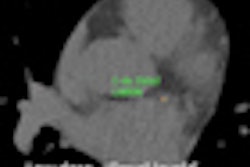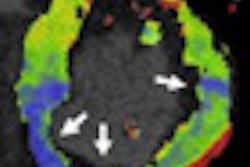
CHICAGO - Coronary artery calcium (CAC) scoring has enormous value for predicting future cardiac events, according to decades of solid research. But it falls short of coronary CT angiography (CCTA) for predicting the presence of obstructive disease in patients with acute chest pain, said researchers from Parma, Italy, in a presentation at the RSNA 2011 congress.
Particularly for patients with lower calcium scores, CAC was less predictive of future events in patients with acute chest pain, they concluded.
"CT can be used in chest pain because it requires less time and less money to get the diagnosis," with high sensitivity and high negative predictive values for coronary artery disease, said Dr. Erica Maffei of Gustavo III hospital in Parma. "In fact, CT has been recently implemented in the recent guidelines of the European Society of Cardiology concerning chest pain," she said. Nevertheless, the relationship between CCTA and CAC has not been fully evaluated. In previous studies, CAC scoring has been evaluated as a tool for risk stratification among asymptomatic patients, but there are no studies comparing its diagnostic accuracy versus CCTA, she noted.
In their study, Maffei and her colleagues aimed to evaluate the diagnostic efficacy of CCTA and CAC scoring for detecting significant stenosis in 237 patients (187 men, mean age 63 ± 10 years) who had undergone both CCTA and CAC scoring, as well as conventional angiography, after presenting with acute chest pain.
All patients underwent low-dose CCTA and calcium scoring in a 64-detector-row scanner (Sensation Cardiac 64, Siemens Healthcare) following injection of iodinated contrast. Patients were divided into five groups based on Agatston calcium scores of 0, 1-100, 101-400, 401-1000, or greater than 1000. Luminal stenosis of 50% or greater at CCTA was considered significant obstruction.
The prevalence of obstructive disease was 53% at CCTA with a similar trend for positive and negative predictive values. "Patients with a calcium score above 400 had a very high prevalence of obstructive disease -- 100%," Maffei said. On the other hand, the absence of coronary calcification didn't rule out the presence of obstructive disease. In all, 74% of patients (n = 185) had a zero calcium score, but 15% of these had obstructive disease at CCTA. Among the CCTA positives, 15% (n = 18) had noncalcified plaque, while 36% (n = 11) had calcified plaque not shown at CAC scoring because it was below the threshold for calcium scoring.
"The diagnostic value of CCTA was excellent in terms of sensitivity and positive and negative predictive values regardless of the class of calcium score," she said. "But we found slightly lower specificity and positive predictive value in patients whose calcium score was between 100 and 400."
Of the 28 additional lesions found at CCTA, 93% (n = 6) were nonobstructive plaque while 7% (n = 2) patients harbored obstructive disease. Counting the obstructive disease diagnoses and the patients with subclinical coronary artery disease at CCTA, the total incremental value of CCTA was 12% (n = 22) of patients.
Heterogeneity of the population was cited as a study limitation, as well as the small cohort. In addition, prognostic data are still being collected, Maffei said.
"CCTA is an excellent tool to identify obstructive coronary artery disease, especially in patients with acute chest pain and non-ST elevation myocardial infarction," she noted. CCTA has broad predictive value, especially in patients with calcium scores under 400.
"Our data suggest that calcium scoring alone can be fine for patients with a calcium score above 400, and we can decide to refer patients to coronary angiography, but more prospective multicenter studies are needed to confirm these data," Maffei said.
Session moderator Dr. U. Joseph Schoepf, from the Medical University of South Carolina, suggested that a cohort of patients who had undergone all three tests might represent a selected population with a strong clinical bias toward obstructive disease. Maffei said the presence of acute chest pain was even more selected, but said the registry data should still be of value for determining the diagnostic accuracy of CAC scoring.



















